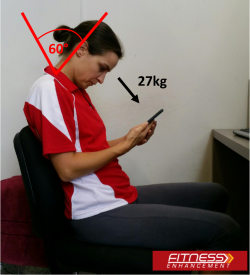Did you know that looking at your smartphone or tablet can double or triple the weight of your head and can strain your neck? If you are reading this article on a cell phone or tablet, you are probably doing it right now: tilting your head forward and down in order to look at your device. The use of smart phones, tablets and other handheld devices influences our posture and body mechanics to contribute to muscle imbalances, dysfunctional movement and pain.
How much does a human head weigh?
Typically, an adult human head weighs between 4.5 – 5.5kg. As the head tilts or angles forward, the neck muscles, tendons, and ligaments support the head. Even the neck’s intervertebral discs are involved and help absorb and distribute the forces exerted on the neck.
 How much heavier is the human head when tilted forward?
How much heavier is the human head when tilted forward?
One study reported that the strain on your neck rises as the forward angle of your head increases as seen below
- At 15 degrees of forward tilt may equate to a head weighing 12kg
- At 30 degrees forward, the strain on the neck equals a 18kg head
- 45 degrees forward equals 22kg of strain
- 60 degrees forward equals 27kg
As you tilt your head, you also move your shoulders forward into a rounded position, which is another aspect of poor posture leading to imbalanced muscles, tightness, tension and pain.
Now consider that the average person holds their head forward to look at a phone or read a tablet for 2 to 4 hours a day; teenagers even more. All this excess strain creates extra wear and tear on the structures of the neck, upper spine and back. In addition to muscle tightness and pain, chronic neck pain and headaches – it can lead to spinal degeneration which may require surgery.
 How to minimise the damage?
How to minimise the damage?
It’s simply not realistic to suggest ‘stop using your phone’. So in a world where so much of our time is spend on our devices what can you do to minimise the damage?
- Don’t use your cell phone or your tablet for extended computer work
- Use your desktop or laptop for extended work and make sure these devices are set up ergonomically correctly.
- When you use a cell phone, instead of bending your head to look down at it, raise your phone up to eye level.
Practice good posture
In addition to better device use, practicing good posture can help prevent neck or back pain from developing. Good posture means that your head is upright, your ears are in line with your shoulders, and your shoulder blades are down and retracted. It’s also important to stretch the muscles that are too tight, and strengthen the muscles that are weak to help reduce chronic strain on your spine.

 How to minimise the damage?
How to minimise the damage?